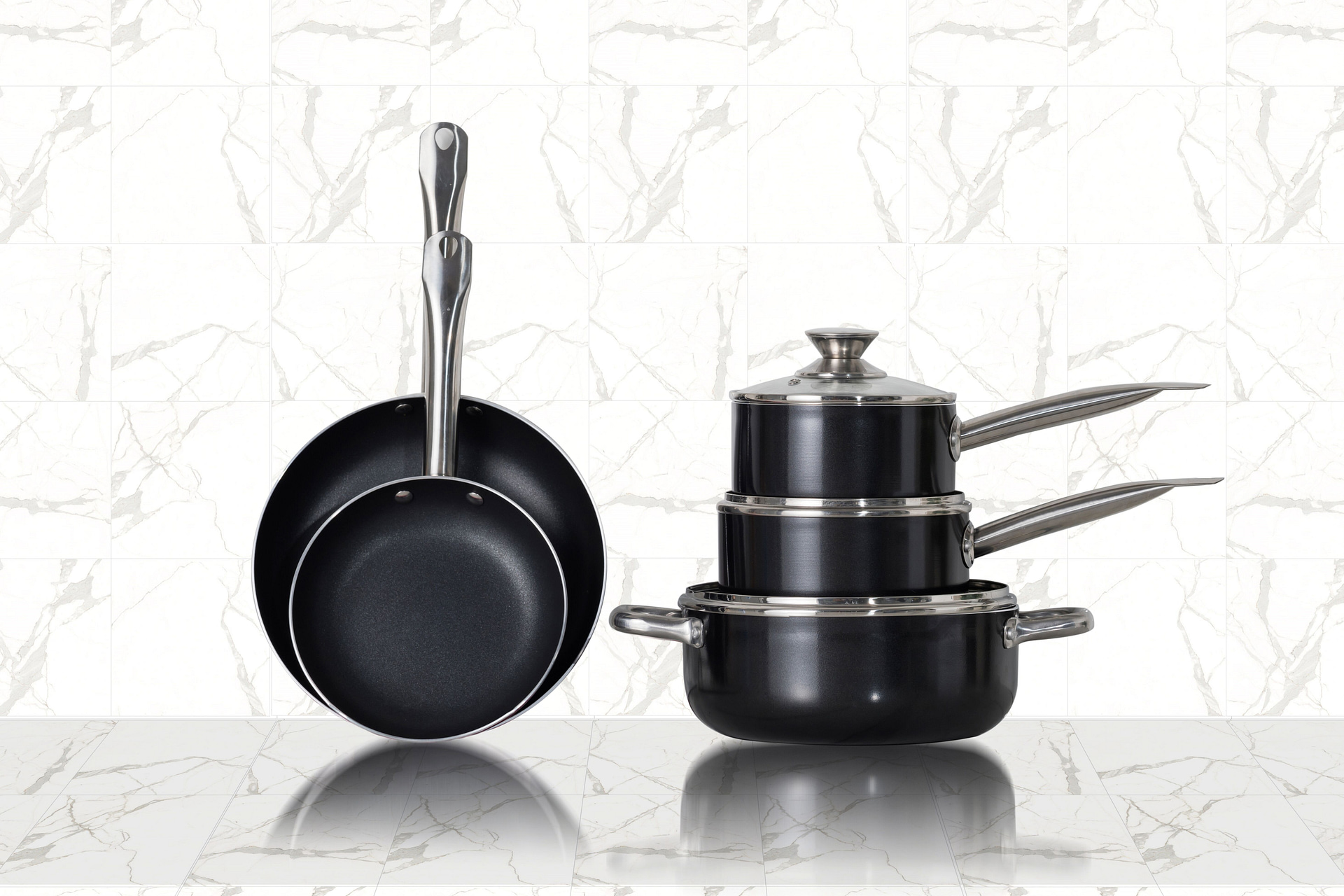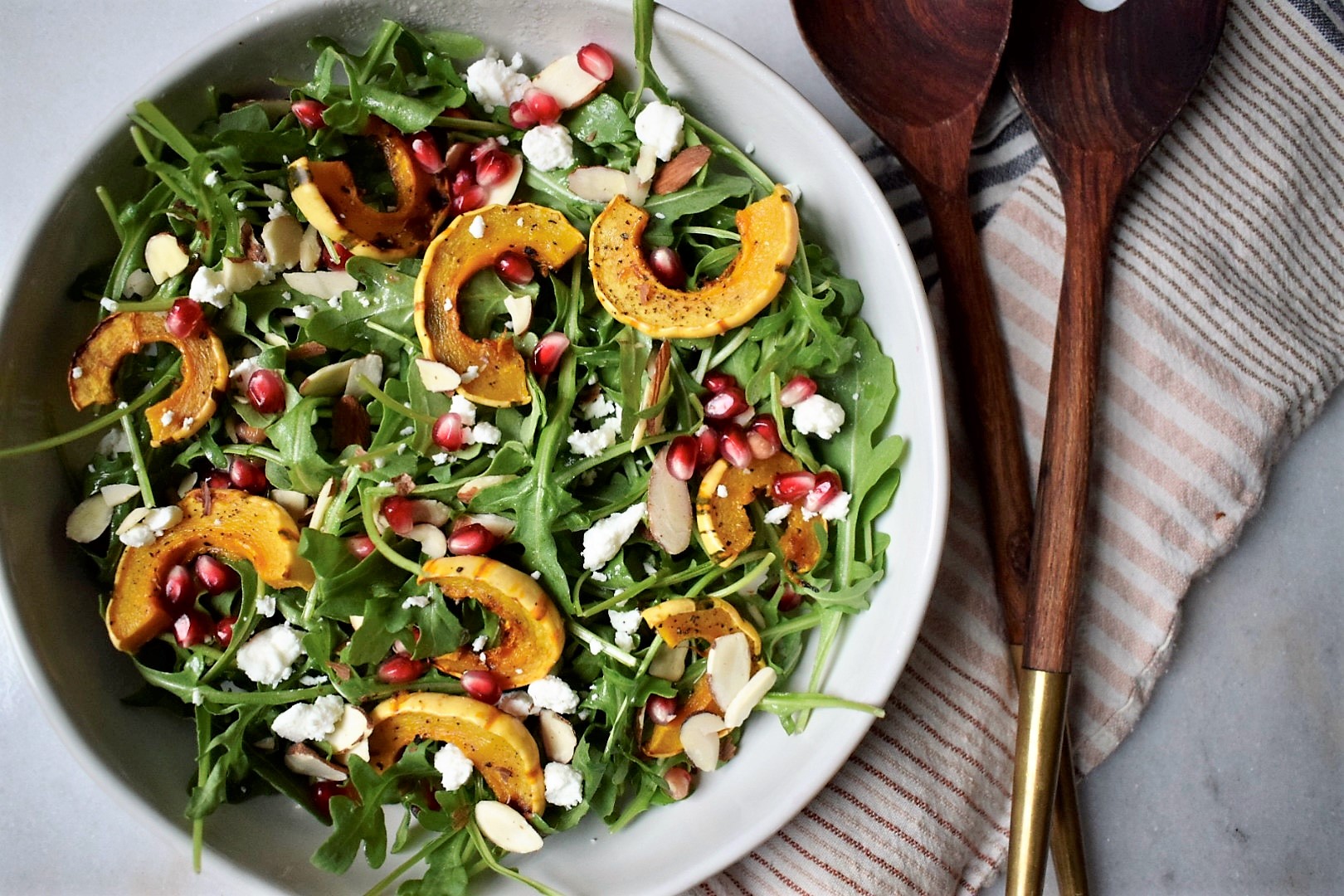Many people have aske me about cookware and what I think about nonstick pans. It’s a topic I’m passionate about because I see it as an intersection of healthy living and clean eating. If you care about what you put in your mouth (and into your body), it’s important to think about what touches your food– especially anytime you add heat since that causes industrial chemicals that are in traditional nonstick coatings and plastics to breakdown faster and leach into food and drinks.
Below I’ve outlined the two main types of nonstick cookware, the category I recommend, care tips, and more.
Not all nonsticks are created equal.
First of all, it’s important to know that “nonstick” is an umbrella terms that encompasses cookware made of various materials. There are some important differences, so here’s a high-level breakdown of two main categories and a few things to look out for:
Traditional nonstick (Teflon) / PTFE (black coating)

Why I recommend avoiding cookware with traditional nonstick (PFSA / PTFE) coating
Traditional nonstick cookware uses a coating made of toxic compounds called PFAS (Perfluorinated Substances), which include PFOA and PTFE. These chemicals can leach into food and are inhaled during the cooking process. The original Teflon was made of PFOA, which is now banned in the US and more than 180 other countries around the world because it’s associated with a long list of serious health risks including: various cancers, hormone problems, kidney damage, liver problems, thyroid disease, weakened immunity and fertility issues, including decreased sperm count.
The problem with PFOA replacements
Unfortunately, PFOA has been replaced in traditional nonstick cookware with PTFE, another chemical in the same family. Many believe it to be just as dangerous, particularly when overheated. After all, it’s well known that it can kill birds indoors under normal cooking temperatures and conditions. Not a good sign! Don’t be fooled when a product touts a “PFOA-free” claim. I would assume it’s made with PTFE or something else in the PFAS family unless those are specifically called-out. Side note: this is very similar to what’s happened with BPA. After getting so much bad press and finally being banned in certain products (after a LONG time coming), it’s just been replaced with slightly modified versions– i.e. BPS, which is likely just as harmful as BPA.
PFAS and PTFE Environmental concerns & persistence in the body
These chemicals are also serious environmental pollutants. They’re referred to as “forever chemicals” because they break down very slowly in the environment and the body. The Environmental Protection Agency (EPA) states that “because of their widespread use and their persistence in the environment, many PFAS are found in the blood of people and animals all over the world and are present at low levels in a variety of food products and in the environment. PFAS are found in water, air, fish, and soil at locations across the nation and the globe.” In another example of bioaccumulation, this Body Burden report shows how these persistent chemicals (among others) can be passed from mother to baby in utero.
Learn more about Teflon and PFAS
If you’re interested in learning more about the history of Teflon and PFAS, I recommend the documentary The Devil We Know. It also provides shocking but important insight into federal regulations, the chemical industry’s lobbying power and the role of special interests.
Other places to look out for traditional nonstick coating and Teflon
Unfortunately, these chemicals have made their way into various household products like dental floss, furniture, carpet, to-go food containers (even from places like Whole Foods until recently), irons, and clothing. When it comes to cookware, keep an eye out for this type of coating in bakeware, pots and pans, air fryers, milk frothers, rice cookers, waffle makers, panini makers, woks and slow cookers. Opt for stainless steel, carbon steel or ceramic instead.
Ceramic nonstick pans

The second nonstick category is ceramic nonstick cookware. These pieces have a different type of coating, which typically does not include PFAS chemicals — though it’s always best to do your due diligence to confirm what’s in the coating of any cookware that you buy. I use (and love) this diamond-infused ceramic-coated non-stick by Food52 because it’s not made with any type of PFAS, lead, or cadmium. The coating is primarily composed of sand and the handle and exterior are stainless steel, so it’s robust and easy to clean. Some cheaper ceramics have a thin coating that chips easily, so keep in mind that there’s a range of quality.
All nonstick pans have a limited lifespan
This goes for ceramic and traditional nonstick products. They usually last about 5 years depending on use and care; they are not heirloom pieces. Because of this, nonstick cookware is less eco-friendly than other types of cookware since most end up in a landfill after just a few years. If they’re not properly cared for, their lifespan is even shorter. As I mentioned above, it’s a whole other environmental impact if you’re talking about traditional (PFAS / PTFE) nonstick.
Caring for nonstick cookware
Ceramic nonstick pans are delicate – they require extra attention and special care. Keep these care tips in mind to prevent damage and extend your pan’s lifespan as much as possible. Note: this applies to all ceramic nonsticks including popular brands like Greenpan, Caraway Home and Our Place’s Always Pan.
- Store w/ felt pan protectors to prevent scratches. The pan I love from food52 comes with one. You can also buy them on Amazon (I use them with my cast iron and stainless steel as well to prevent dings and scratches).
- Use Medium heat or lower. This is one of the biggest mistakes with non-stick pans. None of them are meant for high heat; it will degrade the material and allows oil to burn and carbonize on the surface, effectively blocking the nonstick. This is why I use my nonstick for eggs, but it’s not my go-to for most cooking. I like using Med-High heat for searing, sautéing, stir-frying and a nonstick pan isn’t the right tool for that job. The higher heat is a whole separate (much worse) health issue if you’re talking about a Teflon / black nonstick pan.
- Use wood or silicone cooking utensils, never metal.
- Let the pan cool down to room temperature before hand-washing to prevent warping.
- Stop using a nonstick pan that’s scratched, peeling, or looses its nonstick quality. This is especially important for traditional PTFE/PFAS nonstick pans. These are not pieces you can keep forever. Lifespan is ~5 years depending on use and care. After that, check out Earth911.com and TerraCycle for recycling options. I wouldn’t donate a nonstick pan that’s damaged.

I’ve also shared these tips on Instagram in case you’d like to save the post for future reference (the folder option is pretty cool for reference posts; this is also a great help to me as a content creator – in addition to likes, comments & shares).
My go-to cookware

I love ceramic my nonstick for eggs and occasionally heating up leftovers, but it’s not necessarily something I use every day. I’m not willing to replace my cookware every few years and I AM a fan of high heat cooking (given I’m usually trying to get a meal together ASAP, exclusively cooking on Low / Medium heat doesn’t work for me). I also feel most comfortable cooking the majority of our food in tried and true materials like stainless steel and enameled cast iron. I really love my Staub enamel-coated cast iron pieces (comparable to Le Creuset). Yes, they are pricey, but I view them as investment pieces that cost less in the long run because they’ll last a lifetime. In terms of Stainless Steel, I love the Five Two Essential Cookware collection (it’s slowly replacing my All Clad) because of the thoughtful design details like built-in strainers, heat-safe handles paired with the convenience of glass lids and interior measurement lines.
I hope this covers your questions and helps you find safe and healthy cookware!








